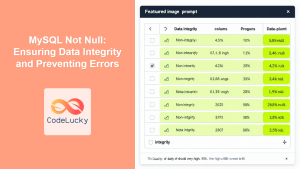In the world of database management, data integrity is paramount. One of the fundamental ways to maintain this integrity is by ensuring that critical fields always contain a value. This is where the SQL NOT NULL constraint comes into play. 🛡️
The NOT NULL constraint is a column constraint that ensures a column cannot have a NULL value. When a column is defined as NOT NULL, it means that it must always contain data; empty values are not allowed. This constraint is crucial for maintaining data consistency and reliability in your database.
Understanding the NOT NULL Constraint
Before we dive into the practical applications of the NOT NULL constraint, let's clarify what NULL actually means in SQL. NULL is not zero, an empty string, or a space. It represents the absence of any value. When a field contains NULL, it means that the data is unknown, unavailable, or not applicable.
The NOT NULL constraint prevents this scenario by requiring that a value must be provided for the column whenever a new record is inserted or updated. If an attempt is made to insert a NULL value into a NOT NULL column, the database will reject the operation and raise an error.
Implementing NOT NULL Constraint
Let's explore how to implement the NOT NULL constraint in various scenarios. We'll use a fictional online bookstore database for our examples.
Creating a Table with NOT NULL Columns
When creating a new table, you can specify which columns should not allow NULL values. Here's an example:
CREATE TABLE books (
book_id INT PRIMARY KEY,
title VARCHAR(100) NOT NULL,
author VARCHAR(50) NOT NULL,
price DECIMAL(10, 2) NOT NULL,
publication_date DATE,
isbn VARCHAR(13) NOT NULL
);
In this example, we've created a books table where title, author, price, and isbn are marked as NOT NULL. This means these fields must always contain a value. The publication_date field, however, can be NULL if the information is not available.
Adding NOT NULL Constraint to Existing Columns
If you have an existing table and want to add a NOT NULL constraint to a column, you can use the ALTER TABLE statement. However, before adding the constraint, you need to ensure that the column doesn't contain any NULL values.
Let's say we have a customers table, and we want to make the email column NOT NULL:
-- First, update any existing NULL values
UPDATE customers
SET email = '[email protected]'
WHERE email IS NULL;
-- Then add the NOT NULL constraint
ALTER TABLE customers
MODIFY email VARCHAR(100) NOT NULL;
Removing NOT NULL Constraint
If you need to remove a NOT NULL constraint, you can use the ALTER TABLE statement again:
ALTER TABLE customers
MODIFY email VARCHAR(100) NULL;
This statement changes the email column to allow NULL values.
Practical Examples of NOT NULL Constraint
Let's dive into some practical examples to see how the NOT NULL constraint works in real-world scenarios. We'll continue using our bookstore database for these examples.
Example 1: Inserting Data into a Table with NOT NULL Constraints
Let's try to insert some data into our books table:
INSERT INTO books (book_id, title, author, price, publication_date, isbn)
VALUES (1, 'The Great Gatsby', 'F. Scott Fitzgerald', 12.99, '1925-04-10', '9780743273565');
This insertion will succeed because we've provided values for all NOT NULL columns.
Now, let's try to insert a record with a NULL value in a NOT NULL column:
INSERT INTO books (book_id, title, author, price, publication_date, isbn)
VALUES (2, 'To Kill a Mockingbird', NULL, 14.99, '1960-07-11', '9780446310789');
This insertion will fail because we're trying to insert a NULL value into the author column, which is defined as NOT NULL. The database will raise an error similar to:
Error: Cannot add or update a child row: a foreign key constraint fails (`bookstore`.`books`, CONSTRAINT `books_chk_1` CHECK (`author` is not null))
Example 2: Updating Data in NOT NULL Columns
The NOT NULL constraint also applies when updating existing records. Let's try to update the price of a book to NULL:
UPDATE books
SET price = NULL
WHERE book_id = 1;
This update will fail because price is a NOT NULL column. The database will prevent this update and raise an error.
Example 3: Using NOT NULL with DEFAULT
The NOT NULL constraint can be combined with the DEFAULT constraint to provide a default value when no value is specified:
CREATE TABLE orders (
order_id INT PRIMARY KEY,
customer_id INT NOT NULL,
order_date DATE NOT NULL DEFAULT CURRENT_DATE,
total_amount DECIMAL(10, 2) NOT NULL
);
In this example, if we don't specify an order_date when inserting a new order, it will automatically use the current date:
INSERT INTO orders (order_id, customer_id, total_amount)
VALUES (1, 100, 59.99);
This insertion will succeed, and the order_date will be set to the current date.
Benefits of Using NOT NULL Constraint
Implementing NOT NULL constraints in your database design offers several advantages:
-
Data Integrity 🛡️: NOT NULL ensures that essential data is always present, maintaining the integrity and reliability of your database.
-
Improved Query Performance 🚀: Queries can be optimized better when the database engine knows a column will always contain a value.
-
Clear Data Model 📊: NOT NULL constraints make your data model more explicit, clearly indicating which fields are required.
-
Application Reliability 💪: By enforcing data requirements at the database level, you reduce the risk of application errors due to missing data.
-
Simplified Data Analysis 📈: When all records have values for critical fields, data analysis becomes more straightforward and accurate.
Best Practices for Using NOT NULL Constraint
While the NOT NULL constraint is a powerful tool for ensuring data integrity, it's important to use it judiciously. Here are some best practices to keep in mind:
-
Use NOT NULL for Required Data: Apply the NOT NULL constraint to columns that must always have a value. For example, in an employee table, columns like employee_id, first_name, and last_name should typically be NOT NULL.
-
Consider DEFAULT Values: For columns that should always have a value but might not always be provided explicitly, consider combining NOT NULL with a DEFAULT constraint.
-
Be Cautious with Existing Data: When adding a NOT NULL constraint to an existing column, ensure that there are no NULL values in that column first. Otherwise, the alteration will fail.
-
Document Your Constraints: Clearly document which columns have NOT NULL constraints and why. This helps other developers understand your database design.
-
Balance with Flexibility: While data integrity is crucial, be mindful not to over-constrain your database. Some fields might legitimately be unknown or not applicable in certain cases.
Common Pitfalls and How to Avoid Them
When working with NOT NULL constraints, there are a few common issues you might encounter. Let's look at these pitfalls and how to avoid them:
Pitfall 1: Adding NOT NULL to a Column with Existing NULL Values
If you try to add a NOT NULL constraint to a column that already contains NULL values, the operation will fail. To avoid this:
- First, update all NULL values in the column to a suitable default value.
- Then add the NOT NULL constraint.
Example:
-- Update NULL values
UPDATE employees
SET phone_number = 'Unknown'
WHERE phone_number IS NULL;
-- Add NOT NULL constraint
ALTER TABLE employees
MODIFY phone_number VARCHAR(20) NOT NULL;
Pitfall 2: Forgetting to Handle NULL in Application Code
Even with NOT NULL constraints in place, it's a good practice to handle potential NULL values in your application code. This provides an extra layer of protection and can make your application more robust.
Pitfall 3: Overusing NOT NULL
While NOT NULL is useful for maintaining data integrity, overusing it can make your database schema inflexible. Consider carefully whether a column truly needs to be NOT NULL. For example, in a users table, while email might be required (NOT NULL), middle_name probably shouldn't be.
Pitfall 4: Ignoring NOT NULL in Foreign Keys
When defining foreign keys, remember that if the referenced column is NOT NULL, the foreign key column should typically also be NOT NULL. Otherwise, you might end up with records that don't have a valid reference.
CREATE TABLE orders (
order_id INT PRIMARY KEY,
customer_id INT NOT NULL,
FOREIGN KEY (customer_id) REFERENCES customers(customer_id)
);
In this example, customer_id in the orders table is NOT NULL, ensuring that every order is associated with a valid customer.
Advanced Usage: NOT NULL with Check Constraints
You can combine NOT NULL constraints with CHECK constraints for even more powerful data validation. For example, you might want to ensure that a price is not only always present (NOT NULL) but also always positive:
CREATE TABLE products (
product_id INT PRIMARY KEY,
product_name VARCHAR(100) NOT NULL,
price DECIMAL(10, 2) NOT NULL CHECK (price > 0)
);
This ensures that every product must have a name and a price, and the price must be greater than zero.
Conclusion
The NOT NULL constraint is a fundamental tool in SQL for maintaining data integrity and ensuring that critical information is always present in your database. By preventing the insertion of NULL values into specified columns, it helps create a more reliable and consistent data structure.
Remember, while NOT NULL is powerful, it should be used thoughtfully. Always consider the nature of your data and the requirements of your application when deciding which columns should be NOT NULL. When used correctly, NOT NULL constraints can significantly improve the quality and reliability of your database.
As you continue to work with databases, you'll find that mastering constraints like NOT NULL is crucial for building robust, efficient, and reliable database systems. Keep practicing, and you'll soon find yourself designing database schemas that are not just functional, but truly optimized for your specific needs. Happy coding! 🚀👨💻👩💻



















